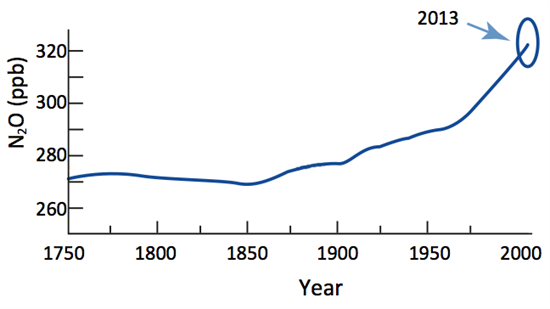Robert McSweeney
28.10.2014 | 5:42pmEmissions of nitrous oxide could double by the middle of the century if left unchecked, a new study finds. And nitrous oxide is the third biggest contributor to manmade climate warming. So should we be worried?
Laughing gas
Most people know nitrous oxide as ‘laughing gas’, used as a mild anaesthetic by doctors and dentists. But it is also a powerful greenhouse gas.
Nitrous oxide is the third-largest contributor to the manmade greenhouse effect, after carbon dioxide and methane.
A new study, published in the journal Environmental Research Letters, brings together all the projections for future nitrous oxide emissions from different researchers. The results show that on average emissions will increase 83 per cent by 2050, if we carry on with business as usual.
The study also looks at how emissions might be curbed between now and the middle of the century. If ‘moderate’ attempts are made, the study finds, nitrous oxides would still increase by around 26 per cent. But emissions could reduce by as much as 22 per cent if we really get our act together.
All the projections were made using a starting point of 2005. This means the researchers are able to see how actual nitrous oxide emissions in recent years compare to the different scenarios. And the bad news is that we’re currently on the business-as-usual path, the researchers say.
Human activities
Bacteria release nitrous oxide naturally by breaking down nitrogen in the soil and oceans. Total emissions from natural sources are currently around twice those of emissions from human activities.
But while natural emissions have not changed significantly since the industrial revolution, manmade emissions have. This increase has caused nitrous oxide concentrations in the atmosphere to rise steadily since the the mid-19th century, as shown below.
Atmospheric concentration of nitrous oxide from 1750 to 2013 (in parts per billion). IPCC [adapted by Carbon Brief]
About 66 per cent of manmade nitrous oxide emissions come from agriculture. Nitrous oxides are emitted from the nitrogen in fertilizer, manure and crop residues. The next most important sources are burning fossil fuels for energy and transport, making up 15 per cent of emissions, and forest fires and biomass cookstoves at 11 per cent.
Warming impact
Although there’s far less nitrous oxide in the atmosphere than carbon dioxide, it’s an important greenhouse gas for two principal reasons: it’s very efficient at absorbing energy, and it stays in the atmosphere for a long time.
Once emitted, nitrous oxide stays in the atmosphere for about 120 years. Over 100 years, each molecule has a warming impact almost 300 times that of carbon dioxide, and around 9 times greater than methane.
In addition to its warming impact, nitrous oxide also depletes the ozone layer. Since the Montreal Protocol restricted the use of chlorofluorocarbons (CFCs), nitrous oxide is now the most significant ozone-depleting substance in the atmosphere.
The study draws attention to nitrous oxide emissions and acts a reminder that carbon dioxide isn’t the only greenhouse gas that needs to be addressed. While the research doesn’t discuss what action can be taken, it does flag some upcoming problems. For example, the potential impact of expanding biofuel production isn’t currently included in nitrous oxide projections, but the authors say it “could become the most significant source to date”.
The study examines what might happen if we have a future biofuel boom. However, with so many uncertainties in predicting adoption of biofuels, the estimates of nitrous oxide emissions cover a wide range. At the low end, emissions from biofuel production could be negligible, but at the top end they could be almost double existing manmade emissions. So – yet another complicating factor to consider as we think about how to decarbonise.
Davidson, E. & Kanter, D. (2014) Inventories and scenarios of nitrous oxide, Environmental Research Letters, doi:10.1088/1748-9326/9/10/105012


